The first faregate is installed at Marine Drive Station
The first faregate is installed at Marine Drive Station
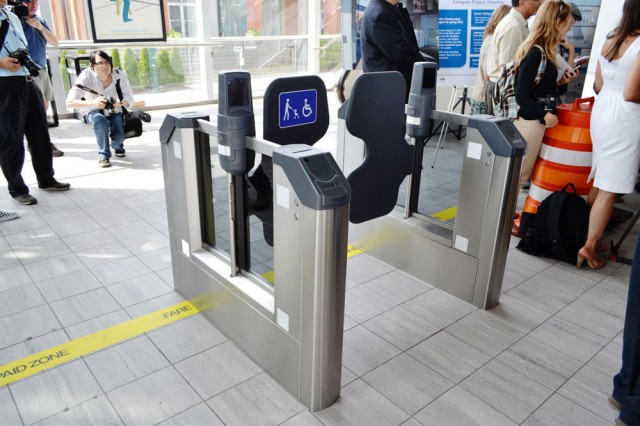
We installed the first faregate at Marine Drive Station today, Monday August 13, 2012!
Check it out if you’re going by the station: the faregate is permanently installed, though it won’t be operational until sometime in 2013 when all the gates are ready.
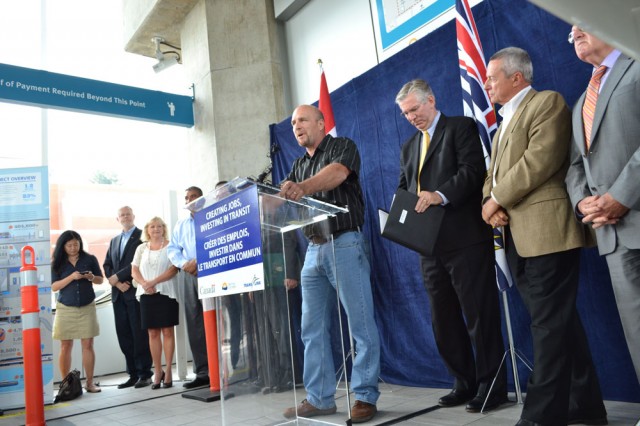
Three key folks were on hand to put the faregate in the ground today:
- Wai Young, Member of Parliament for Vancouver South,
- the Honourable Blair Lekstrom, Minister of Transportation and Infrastructure and Member of the Legislative Assembly for Peace River South, and
- Doug Kelsey, chief operating officer for TransLink.
You can see a few more pictures from the event in this Flickr set.
How does the faregate work?
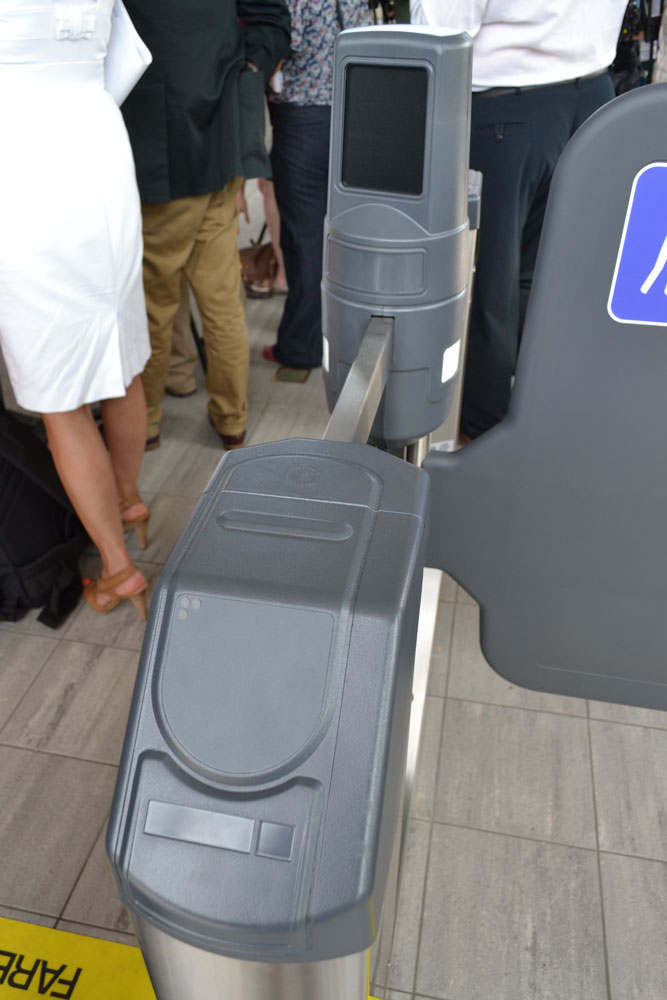
As mentioned, the faregate isn’t operational yet. But it works by tapping your smartcard on the angled panel on the side of the gate. The screen on top will then display whether your card has been accepted, and then the gates should open to let you through.
Also, this gate is particularly wide because it’s for people taking bigger items onto the system, like a stroller or wheelchair. A typical gate will be narrower. Here’s an illustration showing what the gates will look like when done.
So what’s next?
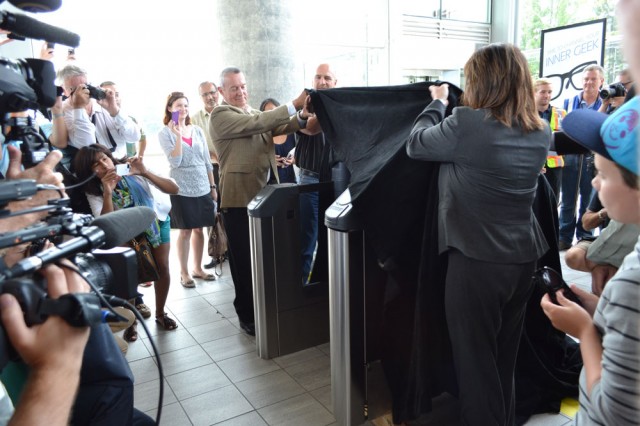
The event marks the start of phase two of faregate installation. Phase one started in July 11, 2011 with stations undergoing various station improvements to prepare for the actual installations of the gates.
After this installation at Marine Drive, other SkyTrain stations will be outfitted with fare gates and accompanying fare media machines. Installation of faregates and fare media machines will begin on Canada Line stations first, then to the Millennium and Expo lines and SeaBus stations followed by West Coast Express. But as mentioned, the faregates, supporting machines and the Compass Card itself won’t be officially operational until sometime in 2013.
We’re installing everything now to make sure everything is in working order once the fare gates and Compass Card are fully online. As you can imagine, with 47 SkyTrain stations as well as SeaBus and West Coast Express stations being updated for faregates and Compass Cards—it will take a little while to get everything in place. The exceptions are Main Street and Metrotown Stations—they will be undergoing major accessibility and capacity upgrades in the future, and we’re planning to install faregates as part of those upgrades in the future. (Due to funding challenges, those projects are currently on hold.)
Faregates by the numbers!
And last but not least, we have a fabulous infographic explaining a great deal of detail about the faregate project! Click the image for a larger version (yes, it gets even larger).
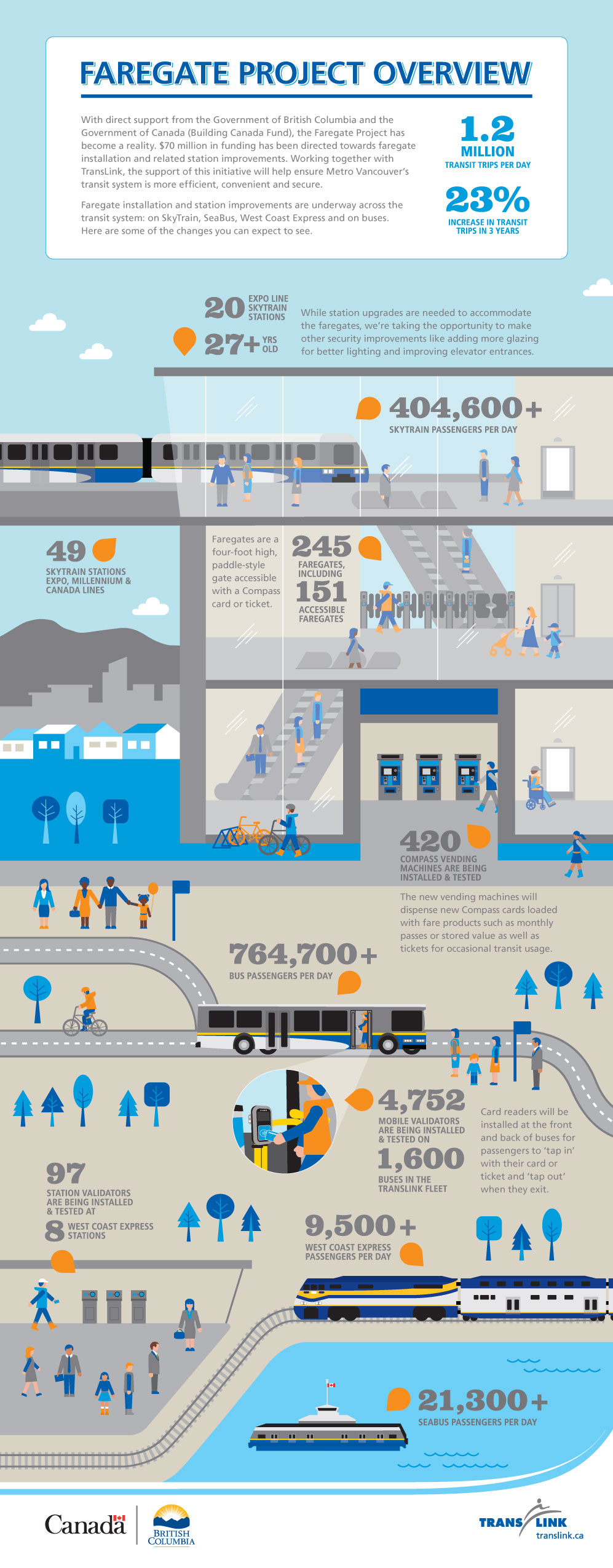
Hope this answers a lot of your questions! Let us know if you have any comments below.






This answers one complaint that many people have had: “Card readers will be installed at the front and back of buses” – perhaps with some kind of gate to be installed in the future?
One question I have for the gates that will be at the stations – will there be separate entrance and exit gates, or will the gates be able to be used for both?
Sheba: It depends on the stations. Gates can be used as entrance or exit gates depending on the particular needs of the station — ie SeaBus has limited entrance/exit points for its passengers.
How about you install the back card reader on the outside of the bus? That way, people will have to get off in order to tap out, and you can charge a maximum fare for the bus trip to the people who try to cheat the system and try to tap out early.
chocodum: I sent your comment to our project team and here is their response.
“One question I have for the gates that will be at the stations – will there be separate entrance and exit gates, or will the gates be able to be used for both?”
Well, if I look at the picture of the card reader on the gate it seems to be on the inside of fare paid zone (based on the direction of the “fare paid zone” banner on the ground). So it looks like this gate is meant to be opened from the inside with a tap of the card, and as we can see the same gizmo on the other side of the gate in the first picture it must be two way!
(puffs pipe)
One problem existing in Asian Faregate systems and clear with the type here: Which side do you tap on to open the fare gate? Right or left. This is particularly confusing because the tap sensors are not angled toward one gate.
I never understood why the same mechanisms on buses (tapable sensors) cannot be placed at stations in favor of gates. This would only be half the cost of gates, and increasing accessibility.
This Doc by Jarvis pretty much sums up the cost: http://www.translink.ca/~/media/Documents/about_translink/governance_and_board/Mayors%20Council%202/2011/February/Smartcard_and_Faregates_Business_Case_Summary.ashx
Kyle: re: your comment about knowing which side to tap on the reader. The little screen on the top will indicate which reader you should tap on to open the gates. For example, here’s the Oyster card gate in London, which indicates the gate reader with a green arrow.
To add to my previous comment, in the rendering, http://buzzer.translink.ca/wp-content/uploads/2012/08/AfterRenderingBoard_MarineDrive_Press.pdf, with 3 gates and 4 sensors, there’s bound to be confusion regarding tapping the left sensor to open the gate, or the right one.
Really not impressed by this new gate. Can we not get transit right in Vancouver? Has anyone used the faregates in Singapore? Amazing! Straightforward, and very quick to get through. http://upload.wikimedia.org/wikipedia/commons/8/85/1G_faregate.JPG
The concept of paddles looks so slow. When someone taps it and walks through, does the person have to wait for the paddles to close before tapping or will the paddles stay open allowing more efficient flow of people? Where is the markers indicating which direction you pass through?
It looks soo bulky. The pdf showing the concept model has what looks like card readers on the gates – hidious. I feel like we’re starting in the stone-ages with this concept. Its been done in many cities before. Surely we can figure out what the best system is.
Will the screen show your remaining balance as well as how much your trip cost as you enter and exit the gate?
Mike: in answer to your question about the screen, here’s what the project team has told me.
They’re the same ones that they use in London and they’re extremely efficient. The system works well on the world’s oldest, most complex transit system.
How will an occasional transit user, who doesn’t have a compass card, pay their fare on a bus? Will they put coins in a box like they do now, but get a card instead of a ticket, then tap on with the card right away?
And how will it work for monthly pass holders before the fare zone system is restructured? Will people with 3-zone and Concession passes (and those with yearly gov’t-issued passes), which permit unlimited travel, still have to tap their card every time even though the distance they travel does not need to be calculated?
Will the “brains” of the compass card system be able to analyze your usage over the month and give you a partial refund if you didn’t use the full capacity of the pass you bought? E.g., if you purchased a 1-zone monthly pass for $81 and applied it to your compass card account, but over the month you only made 20 1-zone trips, which if they had been paid by single cash fares, would have only cost you $50, will the system automatically issue you some kind of credit? Or be able to recommend a more appropriate type/level of pass to purchase the next month, based on your previous month’s usage? That would be cool. :)
Reva: here’s the answers to your questions from the Compass team.
I’d like to know how the monthly passes will work for Sunday travel with family members. Can I still take one adult and up to four children with me on Sundays, using the faregates?
Michelle: The Sunday group offer will still be available. Your group will just go through the wide gate with staff assistance as needed.
Can you take bikes through the wide gates?
I’m wondering if the faregates are going to require increased staffing at each station. If so, what the increased operating costs because of the gates?
Chris: I was guessing the answer to your bike question was “yes,” but here is the official confirmation from the Compass team.
Here’s the response to your question about staffing as well:
How will the Smart cards work with the Annual employee farecard program?
Gordon: here’s the answer to your question from the project team.
PS. If you haven’t seen it, check the Compass Card section of our site: it has an FAQ and a gallery of selected before/after station mockups!
Really hope we can buy monthly passes with unlimited usage.
Ideally the pay-per-use would work as follows: YOu would put a balance on the card. When you enter the system by tapping, it charges you the full fare. When you exit the system, it gives you back your full fare and only charges you the distance, or the number of stations, you had to pass through.
Neal: Unfortunately no, the construction list is not publicly available!
I doubt that an “exit tap” is required since there seems to be no plan switching to fare-by-distance on SkyTrain once the gates are installed and operational. My educated guess is that there would be motion detectors on the fare paid side.
The gates looks likes the ones Muni in San Francisco uses. A quick Google on their gates and found the following:
Geoff: The new Compass card will actually require a tap out for data collection purposes. We’re also planning to reevaluate the fare zone system once Compass is established, and distance-based fares will be a part of that evaluation. We’ll see what happens!
To quote Robert Willis from the fare evasion post:
I asked our Compass Card people about your thoughts regarding staff and the fare gates: Here’s what they said,
“We will not necessarily need attendants right at gates all of the time. There will be faregate monitoring centres for the Expo/Millennium Line and for Canada Line, with staff on duty during all operating hours. These people will be able to control gates remotely and solve problems if a gate malfunctions or a customer’s card doesn’t work properly or, in the case of the ‘group offer’ on Sundays and Holidays, to open the gates to let them all through.
A dedicated customer service phone next to the gates will put passengers in direct contact with the monitoring centre, and our station video network has been expanded to allow staff to see every gate array on the system.”
…and it looks like you understand why I was asking about separate entrance/exit gates Jhen. I can just see it – a busy station where a bus has pulled in and emptied out at a station just as a Skytrain car has done the same thing, and the inevitable crush of people all converging on the gates at the same time, only from different directions. People try and crowd onto the Skytrain before letting people leave, why should the gates be any different?
Thank’s sheba for that information.
I’ve got another question: For school groups going on field trips, currently, the teacher inputs a few stacks of Faresavers for each student. With the Compass, since you can’t tap it twice on one trip, would the teacher need 25 compasses, or pay cash fares?
And how much does a compass cost? (In addition to the fare)
Say i load a monthly pass onto the compass card and I’m going to Richmond on the Canada Line, Then when i tap my card, how do i pay the add fare?
Raymond: your card is able to store a cash balance on it. You can preload your card with, say, $20, and the card will automatically deduct the add fare from that cash balance as needed, as you tap out in the zone of your choice.
Will the compass card be able to have a cash balance loaded on it as well as a monthly pass.
Also say i buy a compass in a grocery store, then does it have a cash balance on it already when i buy it.
Hi Raymond: Yes, the Compass Card will be able to be loaded with the funds you want on it. As for your second question, we’re still working on how the card will work at point of purchase. I hope that helps. We’ll be updating everyone with more info as soon as we have it.
When will the general public be able to get the compass card and use it?
Raymond: Sometime in 2013. The date hasn’t been confirmed yet.
[…] has a massive new infographic about its Faregate project below the […]
Here is an interesting discussion on people reseting fare cards to ride for free.
http://it.slashdot.org/story/12/09/20/2154233/another-eusecwest-nfc-trick-ride-the-subway-for-free
Eugene: I saw this. It’s my understanding that our vender is aware of these types of technologies. They’re constantly updating security to stay one step ahead of the hackers.
Thanks, Robert!
how does it work when one uses a u-pass through a post secondary institution? thanks.
teya: U-Passes will simply be loaded onto the Compass card. So when you tap onto transit, the system will automatically know from your card that you’ve got a U-Pass and will let you on.
wonderful, thank you for your respose.
err response*
Question about what would happen if you came into a station and exited at the same station. Eg Going through stadium from costco to Dunsmuir or entering the station and forgetting something and going back out. Would people w/o monthly passes be charged the whole $2.75 fee?
I see there was a question about the Employer Pass Program and the new faregates. Any new information on how it will work?
Hi there, i understand now that testing is underway, when will the testing be done on the system?
the other question i have is it says operational fall 2013 on the faregates. Fall is this september, so does that mean the compass card will be launched this september?
Hi, Raymond. We will be conducting Beta testing in early fall 2013, analyzing those results, and then beginning transition to the Compass system in late fall 2013.
When is the compass card going to be rolled out to the general public?
Hi Raymond. We’re continuing with a phased approach to the launch of Compass. A phased approach is how other major transit systems have been successful, and it’s the best way to ensure we get it right for our customers. The next group to receive the Compass Card will be post-secondary students. Once we’re satisfied with the performance of the Compass system and our mobile validators, we will move ahead with the transition to Compass for the next group of customers. For more information, you can check out this Buzzer blog post.